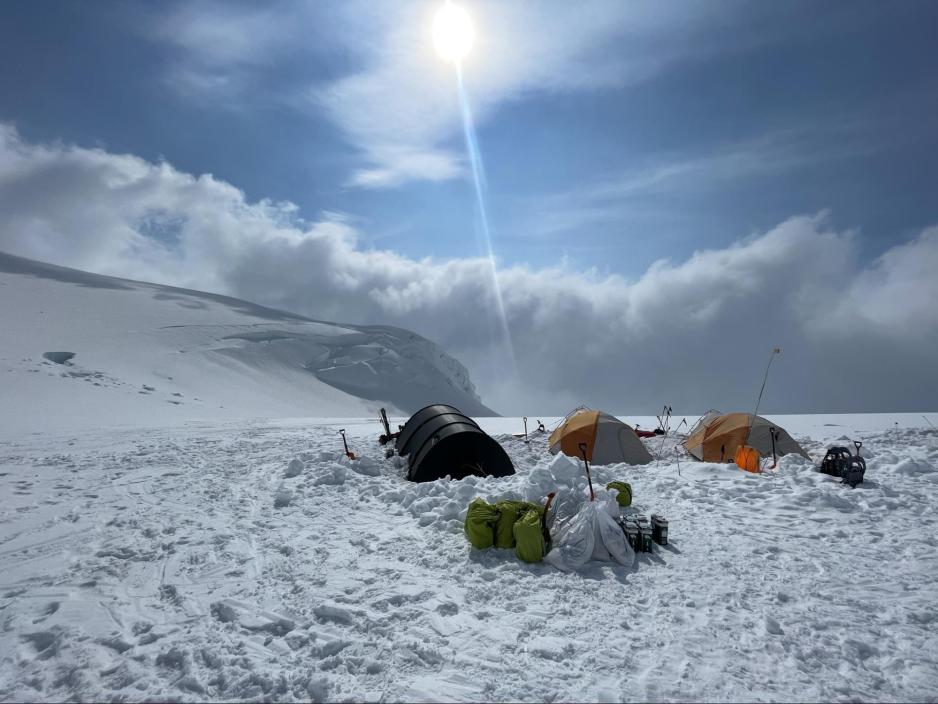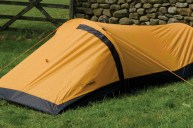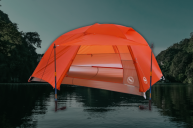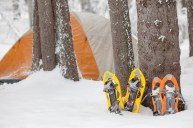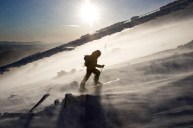The storm had been brewing all week, dark clouds gathering over the mountains. But it still took us by surprise with its strong winds and whiteout conditions when it hit just as we reached camp at 11,000 feet on Denali's West Buttress in Alaska. No strangers to this terrible winter weather, we were able to get our tent set up and anchored in no time and climbed into its cozy interior, exhausted.
While that may sound like a winter survival situation to some, it's a typical workday for me. I've spent six years as a mountaineering guide in Alaska, where it's not unusual for us to get 6 feet of snow, 60-mile-per-hour winds, and -20-degree temperatures—all within the span of a week. Our tents are our lifelines in the mountains, and I know from experience which ones will hold up, and which ones will see you stranded and shelter-less in a snowstorm.
A four-season tent—so-named because it can handle winter's cold and snow, though often that means they're too hot for summer use—is key not only to enjoying but surviving a winter camping trip. Built with thick fabric and strong tent poles, four-season tents can withstand heavy snow loads and strong winds. They're also designed to trap body heat and typically have a larger interior space, giving you plenty of room to stash your gear out of the snow. Whereas a three-season tent would have crumpled in that storm on Denali, our four-season tent provided a warm, comfortable place to sleep, eat, and even play cards while we waited for better weather.
Because they're so specialized, four-season tents are far more expensive than three-season tents. However, if you're planning on camping in heavy snowstorms, high winds, cold temperatures, or in exposed areas, they're well worth the money for extreme mountaineering, winter car camping, or winter backpacking. I've picked out my favorites for you below, after putting many to the test in the worst weather Alaska has to offer.
The Best Four-Season Tents of 2024
- Best Four-Season Tent Overall: Mountain Hardwear Trango 2
- Best Budget Four-Season Tent: Nemo Kunai 2
- Best Four-Season Tent for Car Camping: Cabela's Alaskan Guide Model Geodesic 4-Person Tent
- Best Four-Season Tent for Backpacking: MSR Access 2
- Best Four-Season Tent for Extreme Weather: Hilleberg Nammatj 2 GT
- Best Ultralight Four-Season Shelter: Black Diamond Mega Light
Best Four-Season Tent Overall
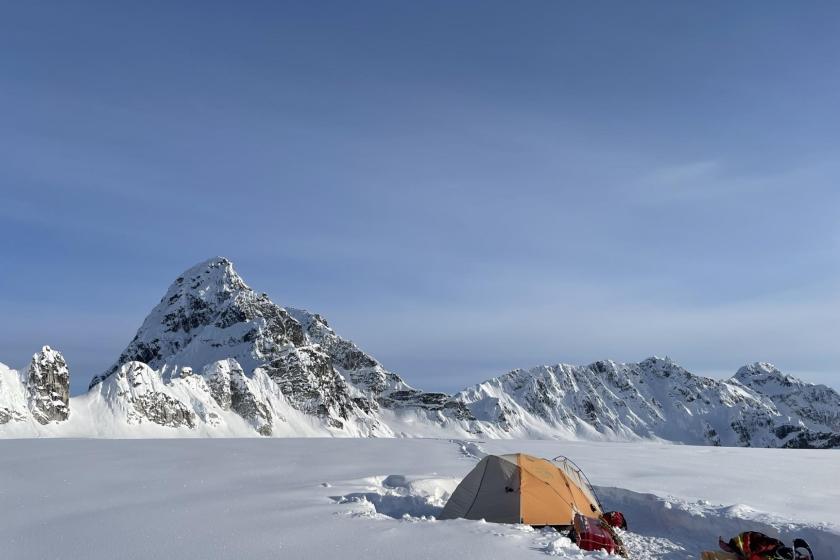
Chelsey Cook for Wide Open Spaces
Top Pick: Mountain Hardwear Trango 2
Number of People: Two (three- and four-person also available) | Floor Area: 40 square feet, plus two vestibules | Packed Size: 8 inches by 25 inches | Weight: 9 pounds, 10 ounces | Vestibules: 2 | Doors: 2
In my and many other mountain guides' opinions, the Trango series is the absolute best overall four-season tent money can buy. It can handle just about anything that winter will throw at you and is a staple while climbing Denali. Nearly every guiding outfitter on the mountain uses this tent for clients, and you'll see their bright patterns no matter what camp you're at, be it base camp or 17,000-foot camp.
Mountain Hardwear's Trango tents are easy and quick to set up, thanks to helpful color coding. The main sleeping area is huge, measuring 7.5 feet by 5.3 feet—40 square feet—for you and your partner, as well as several mesh pockets along the wall to stuff extra gear inside.
The Trango 2 has two doors and two vestibules, but both are on the smaller side. It's difficult to cook in the larger, steeply-sided vestibule, despite having nearly 12 square feet of floor space—no matter where you place your stove, it's always a little too close to the rainfly fabric and needs to be monitored very closely (writes the woman who melted a sizeable hole in her own Trango with a JetBoil). If you're going to cook in any vestibule, keep the door unzipped so that you have good airflow; every year, carbon monoxide poisoning kills winter campers who cook inside. Still, having two means you have options for storing snowy gear inside without getting your sleeping area wet.
That said, because it's so dialed for winter conditions, the Trango is far too warm to use in summer. And, while I've seen them weather almost any snow or wind the mountains can throw at them, there is a comfortable limit. Because of the hexagonal shape of the fly, snow can pile on top of the tent in really heavy storms, stressing the fabric and the poles. This is an easy, albeit annoying, fix; if you're stuck in a storm, you must hop out of the tent every few hours to brush off the snow.
All things considered, if you spend a lot of time camping out during winter, you can't go wrong with the Trango 2. (Mountain Hardwear also offers a Trango 3 (three-person) and Trango 4 (four-person) should you travel with more campers.)
- Easy to set up, with color-coded poles and clips
- Storm- and wind-proof
- Spacious for both people and gear
- Small doors and vestibules
- Difficult to cook in the vestibule
- In really bad conditions, snow can collect on top of the body of the tent
Best Budget Four-Season Tent
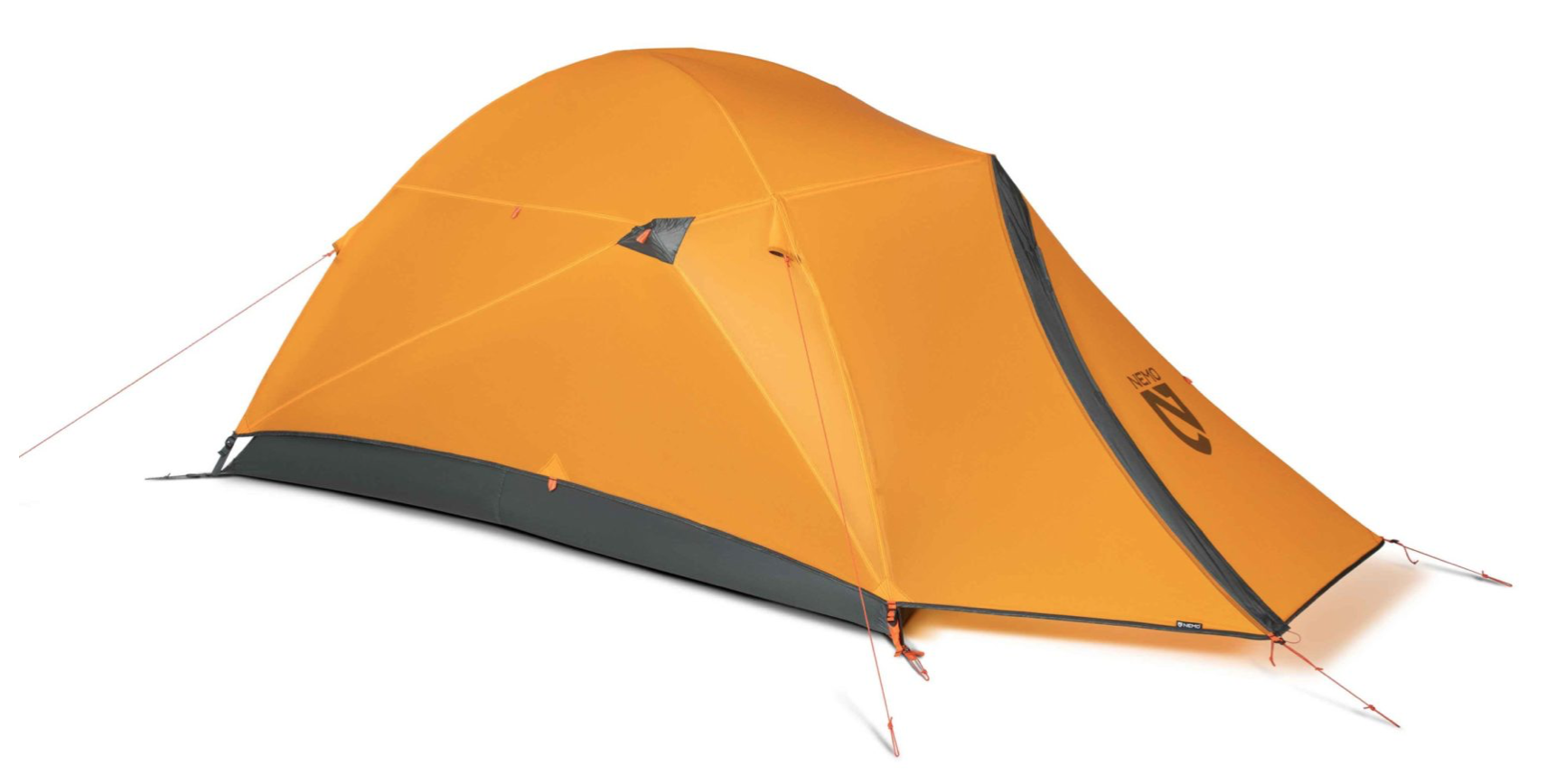
Nemo
Top Pick: Nemo Kunai 2
Number of People: Two (three-person also available) | Floor Area: 26 square feet, plus one vestibule | Packed Size: 7 inches by 20 inches | Weight: 3 pounds, 14 ounces | Vestibules: 1 | Doors: 1
Protection from winter elements comes at a cost, and four-season tents are not cheap. There are few and far between "budget" four-season tents that I'm willing to recommend, but the Nemo Kunai 2 is one I can stand behind. Nemo has a great reputation for mountaineering tents, and while the Kunai is more of a winter backpacker tent, it's plenty storm-worthy for most adventures. It's a double-walled tent with sturdy poles, which lock together to keep you feeling safe from any snow loads.
However, the tent design has a taller peak height and increased surface area, so it doesn't hold up to high winds as well as more elongated tents like the Trango. While you may want something more bombproof if you're venturing out in truly heinous winter conditions, the Kunai excels during summer adventures, where more heavy-duty tents turn into a sauna, making it more truly four-season than others on this list.
The lower cost comes at a price, beyond it being less storm-ready. The Kunai 2 has by far the smallest tent floor area, being only 85 inches by 51 inches, and one of the larger packed sizes, meaning you're carrying a lot of tent but not sleeping in a lot of tent. It has plenty of headroom when sitting up in the main area, but only one door and a tiny vestibule that's just 8 square feet—two-thirds the size of the larger one of the Trango's, making it nearly impossible to cook in. For more perspective, the entire floor area for sleeping plus the vestibule of the Kunai 2 is smaller than the sleeping area alone of the Trango 2 (which has two vestibules to the Kunai's one).
On the other hand, the Kunai 2 is incredibly lightweight at under 4 pounds, beating out many other four-season tents; Trango 2 weighs nearly 10. It also comes in a three-person Nemo Kunai 3 with 43 square feet of living space—on par with the Trango 2, but still lighter to carry—with one large vestibule for $700.
- Affordable as far as four-season tents go
- Easy setup with color-coded tent poles and clips
- More truly four-season, as it won't be too hot for summer
- Small floor space may have you wishing you opted or the three-person version
- Only one door and a small vestibule
- Not as storm-worthy as other options
Best Four-Season Tent for Car Camping
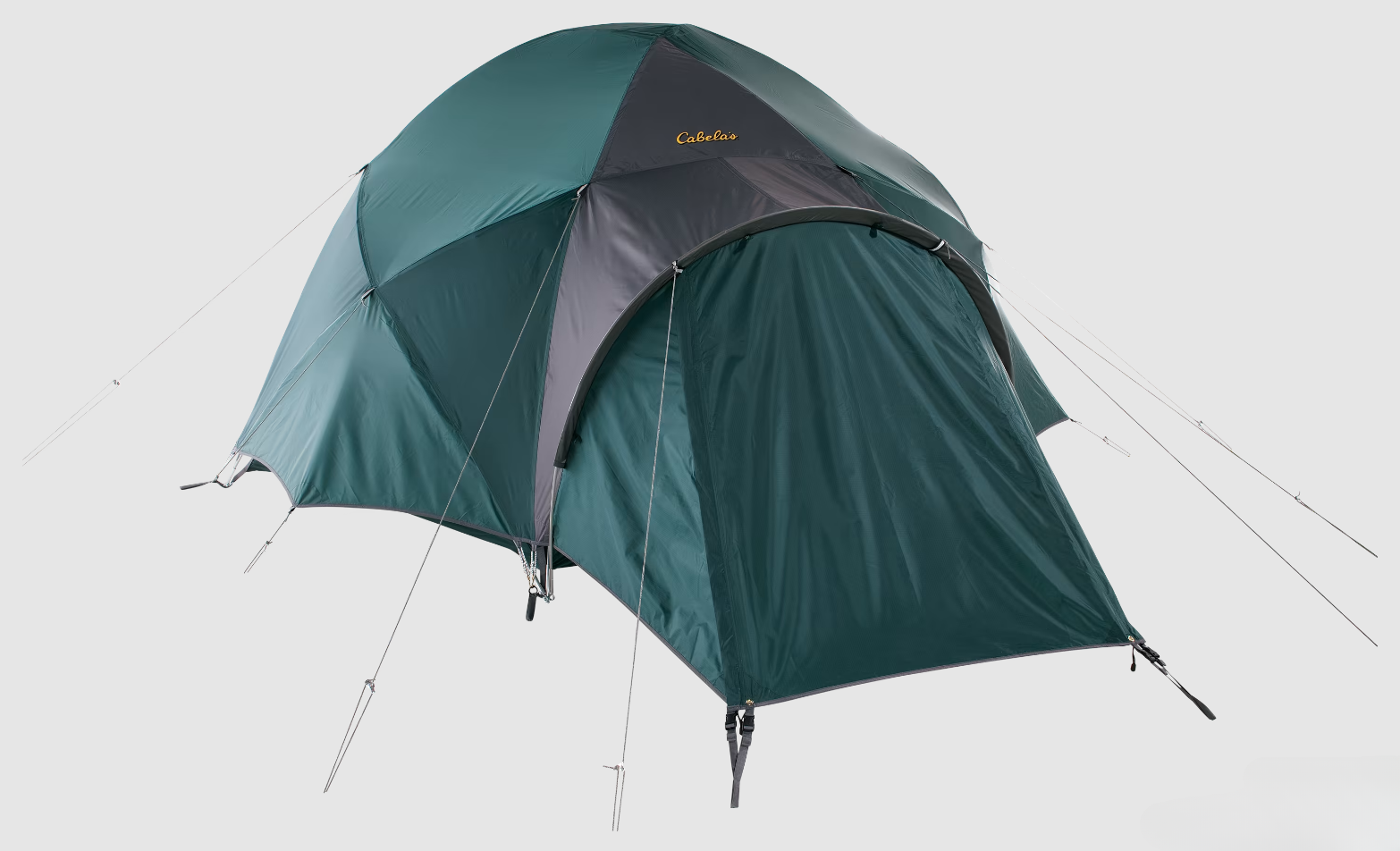
Top Pick: Cabela's Alaskan Guide Model Geodesic 4-Person Tent
Number of People: Four (six-person also available) | Floor Area: 74 square feet, plus one vestibule | Packed Size: 10 inches by 30 inches | Weight: 24 pounds, 11 ounces | Vestibules: 1 | Doors: 1
As a winter car camper, you don't necessarily need the strongest or lightest four-season tent. In fact, for most car-camping situations, you can probably get away with your standard three-season tent. For one, if your tent breaks while winter car camping, it's not necessarily the survival situation it would be if you were truly in the backcountry—you can always hop in your car and find a hotel.
That said, Cabela's Alaskan Guide tent has a lot to offer frequent wintertime car campers who hunker down below the treeline. Not only is it rugged, made of heavy ripstop polyester with a full-coverage rainfly and a sturdy seven-pole system, but it's also ridiculously huge inside. At nearly 74 square feet not counting the vestibule, the Alaskan Guide is designed to accommodate up to four people, with plenty of room even to move cots inside for more comfort. The covered vestibule lets you stash gear out of the element without getting your sleeping area (or the inside of the car) wet. If the four-person somehow isn't big enough, it comes in a six-person version, too.
At nearly 25 pounds, the Alaskan Guide tent is almost three times heavier than the other four-season tents on this list (even in the versions designed for four people). This isn't a problem if you're car camping, but don't plan on carrying the Alaskan Guide anywhere far. Also, because of its size and somewhat complex shape, setup and breakdown will take longer and maybe a challenge in high winds.
- Massive floor space for four people, or even setting up cots
- Large vestibule for gear storage with roll-up door for fairer weather
- Half the price of other four-season tents
- Incredibly heavy to carry, only suitable if you are using a car
- 7-pole system may be confusing to set up
Best Four-Season Tent for Backpacking

MSR
Top Pick: MSR Access 2
Number of People: Two (one-person and three-person also available) | Floor Area: 29 square feet, plus two vestibules | Packed Size: 6 inches by 18 inches | Weight: 4 pounds, 1 ounce | Vestibules: 2 | Doors: 2
The MSR Access 2 is my go-to four-season tent for when I'm winter backpacking. It's light, it has adequate floor space, and it's surprisingly durable. While not quite up to the winds and snow loading that the Trango and Nammatj (my Extreme Weather pick, below) can handle, the Access 2 has steep walls and dome shape, making it well suited to not only handling heavy snow loads but also shedding them. There are also very few buckles or fiddly parts, making it easy to set up no matter how cold your hands are.
The Access 2 is most similar to my Budget pick, Nemo Kunai 2, which is also designed for backpacking. But for the extra money spent, you get a few additional square feet of living area space, plus two doors and two vestibules. This makes storing gear and sharing space much easier, and you don't have to crawl over your partner every time you want to get out.
At just over 4 pounds, the Access 2 is also one of the lightest and most packable full-size, four-season tents you can buy. While tents like the Trango and Nammatj are better suited to long mountaineering trips because of their weather resistance and heft, the Access is designed for stuffing in your backpack for a weekend winter trip.
Though a true four-season tent, I've also used the Access 2 while backpacking in Alaska in the summer. It was warm, but it was far more bearable than other four-season tents like the Trango and Nammatj. The Access also comes in one-person and three-person sizes.
- Lightweight, durable, and packable for winter backpacking
- Two doors and two vestibules make it easy to share space
- Easy to set up with cold hands
- Semi-freestanding, meaning it can be set up without stakes but it takes patience
- The pole system isn't as intuitive as other tents and should be practiced
Best Four-Season Tent for Extreme Weather
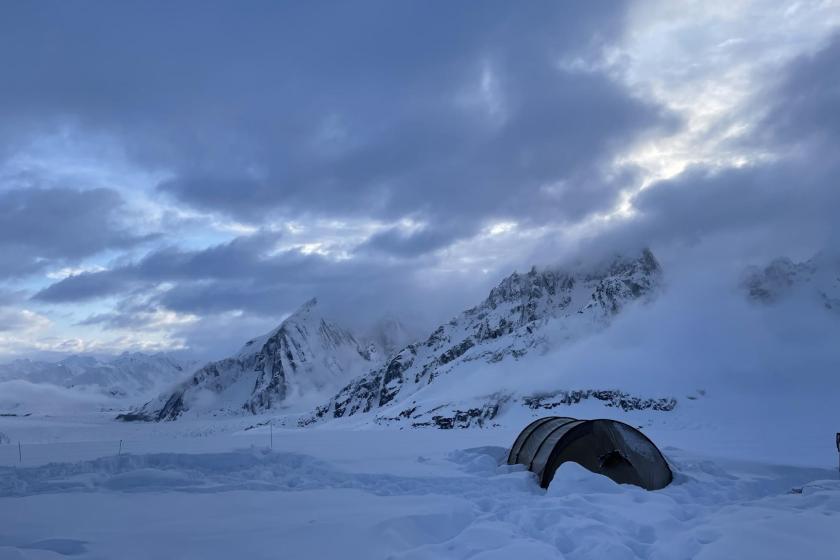
Chelsey Cook for Wide Open Spaces
Top Pick: Hilleberg Nammatj 2 GT
Number of People: Two (three-person also available) | Tent Floor Area: 30 square feet sleeping area plus one large vestibule | Packed Size: 7 inches by 20 inches | Weight: 8 pounds, 3 ounces | Vestibules: 1 | Doors: 1
In my six years of guiding in Alaska, I've seen a lot of tent carnage: tent poles snapping, rainflies ripping, entire tents blowing away. Most of the time, it's caused by human error. But there also comes a point, when it's blowing 60 miles per hour and you're getting 6 feet of snow a week, where some tents just can't hang—even the much-beloved Trango. Not so for Hillebergs. This brand's expedition tents have never failed me and have provided incredible shelter through the worst of weather. While I'm more familiar with the Hilleberg Keron 4 GT, the Nammatj 2 GT is essentially a downsized version—the GT means it has an extended vestibule, and you'll definitely want that.
The Nammatj 2 GT is a tubular tent that looks like a tunnel when pitched. This shape is key to its weather resistance to reduce the effects of wind, though the materials used are no slouch. The outer tent fabric is rated to take up to 40 pounds of snow before tearing, and the poles are 10 millimeters thick, making them unlikely to snap under any loading. Even the zippers are burly on the Nammatj.
The inner bug mesh and the outer rainfly are linked, meaning you can pitch the tent all at once. This not only makes set up quicker, but you also don't have to worry about half your tent blowing away if you're pitching in high winds. The Nammatj 2 GT also has a roomy 25.8-square-foot vestibule that's less steeply sided than the Trango, making it easier to cook in—with the flap open—for those really stormy days.
Of course, this Hilleburg has trade-offs. Its tubular construction offers 10 square feet less sleeping space than the Trango 2—if you require more elbow room, the three-person Nammatj 3 GT is on par with Trango 2. The Hillebergs are also not freestanding, so you'll need to anchor both ends in the snow for the tent to function.
- Able to take on the strongest winds and heaviest snowfall
- Easy to pitch and take down, even in windy conditions
- Large vestibule for gear and cooking
- One of the most expensive four-season tents
- Freestanding and takes practice to set up well
- Less living space than comparable four-season, two-person tents
Best Ultralight Four-Season Shelter
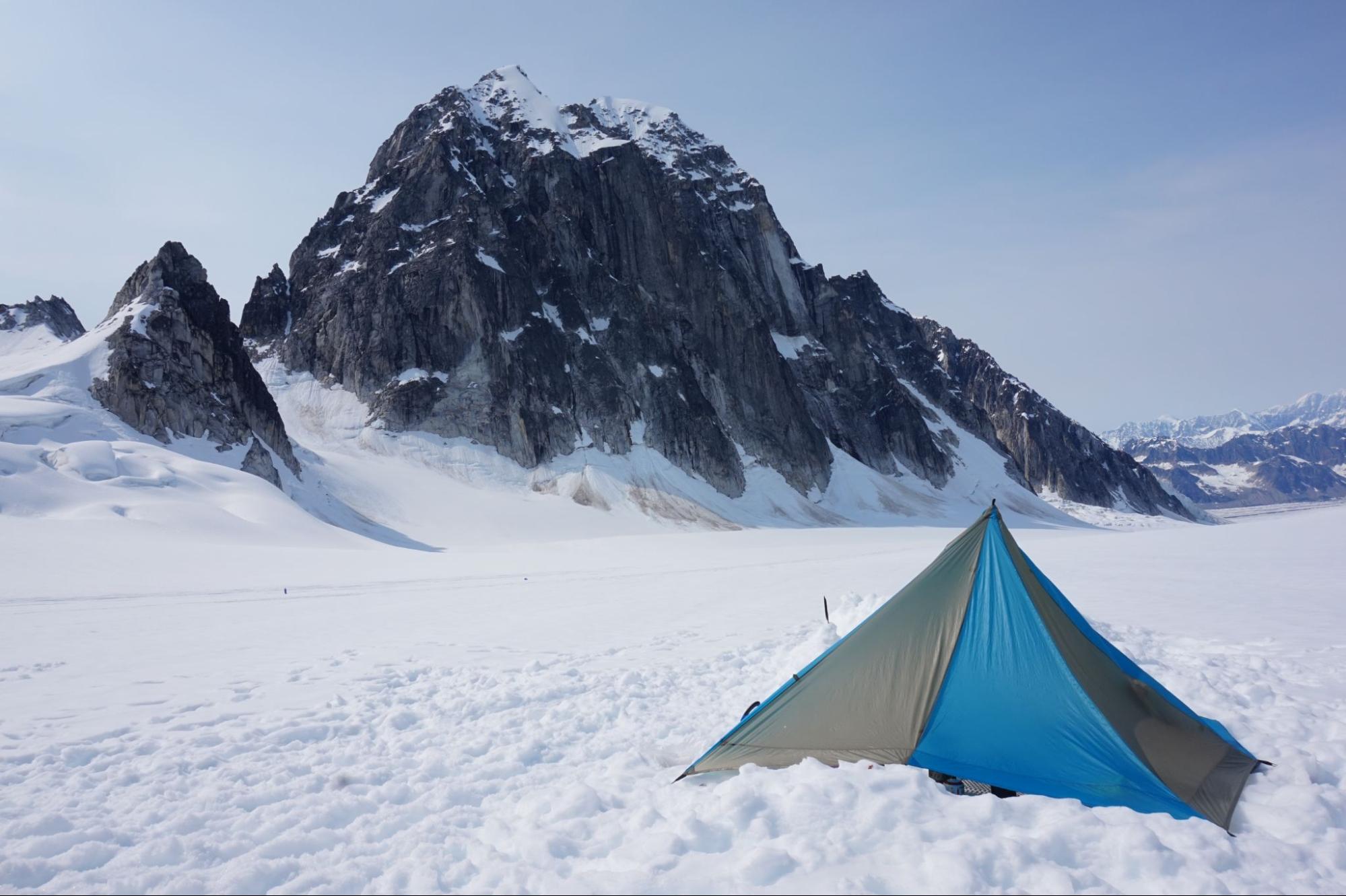
Chelsey Cook for Wide Open Spaces
Top Pick: Black Diamond Mega Light
Number of People: Four | Floor Area: 50 square feet (no vestibule) | Packed Size: 5 inches by 12 inches | Weight: 2 pounds, 13 ounces | Vestibules: 0 | Doors: 1
People who haven't spent much time camping in the snow are always shocked when I claim that the Black Diamond Mega Light, fondly known as the "circus tent" in some circles, is one of the best winter camping shelters out there. While some websites list it as a three-season tent, after hundreds of nights sleeping beneath one in all conditions and hundreds more cooking meals for clients under the cover of one in the Alaska Range, the Black Diamond Mega Light is one of my favorites.
Granted, the Mega Light looks nothing like other four-season tents, and its lack of floor or inner body may be concerning to some who haven't used it. But the beauty of the Mega Light not having its own fabric floor is that on deep snow you can dig whatever floor you want. Snow is an incredible insulator, and I'll typically dig a hole 2-plus feet deep to lay my sleeping pad on, with the shelter pitched above me. I can also dig myself nightstands, cubbies for gear or, if I'm using it for a kitchen, a whole snow-packed countertop! The lack of an inner tent, also known as bug netting, makes it a poor choice if insects are swarming, though you can purchase the netting separately, with the Mega Bug insert. But these features together make the shelter all the more light and versatile, packing down to under 3 pounds and pitching with just a single pole—it can even be pitched with trekking poles!
The tarp-like nature of the Mega Light means some sacrifices. While it can handle snow and strong winds, it can't handle them quite as well as tents such as the Trango or Nammatj can. If you're using it as a sleeping shelter, it's best suited for below-treeline campsites. When used for a camp kitchen, as I do in Alaska, I simply drop the center pole and the fabric when I leave camp for the day so a sudden wind gust won't blast it broadside while I'm gone.
Finally, Black Diamond says it's a four-person tent and it has 50 square feet of floor space, but the steeply angled walls make the actual living space feel quite small, unless you do a lot of digging. I prefer to only sleep two people in the tent when we have a lot of gear (unsurprisingly, this one doesn't have a vestibule).
- Ridiculously lightweight and spacious
- Versatile for sleeping or as a camp kitchen
- Truly four-season for winter, summer, and everything in between
- Half the price of other four-season tents
- No floor or bug net included and no vestibule
- Not the most stormproof and requires tending if in heavy snow or winds
- Can be finicky to set up and may require some snow-digging
What to Look For When Buying a Four-Season Tent
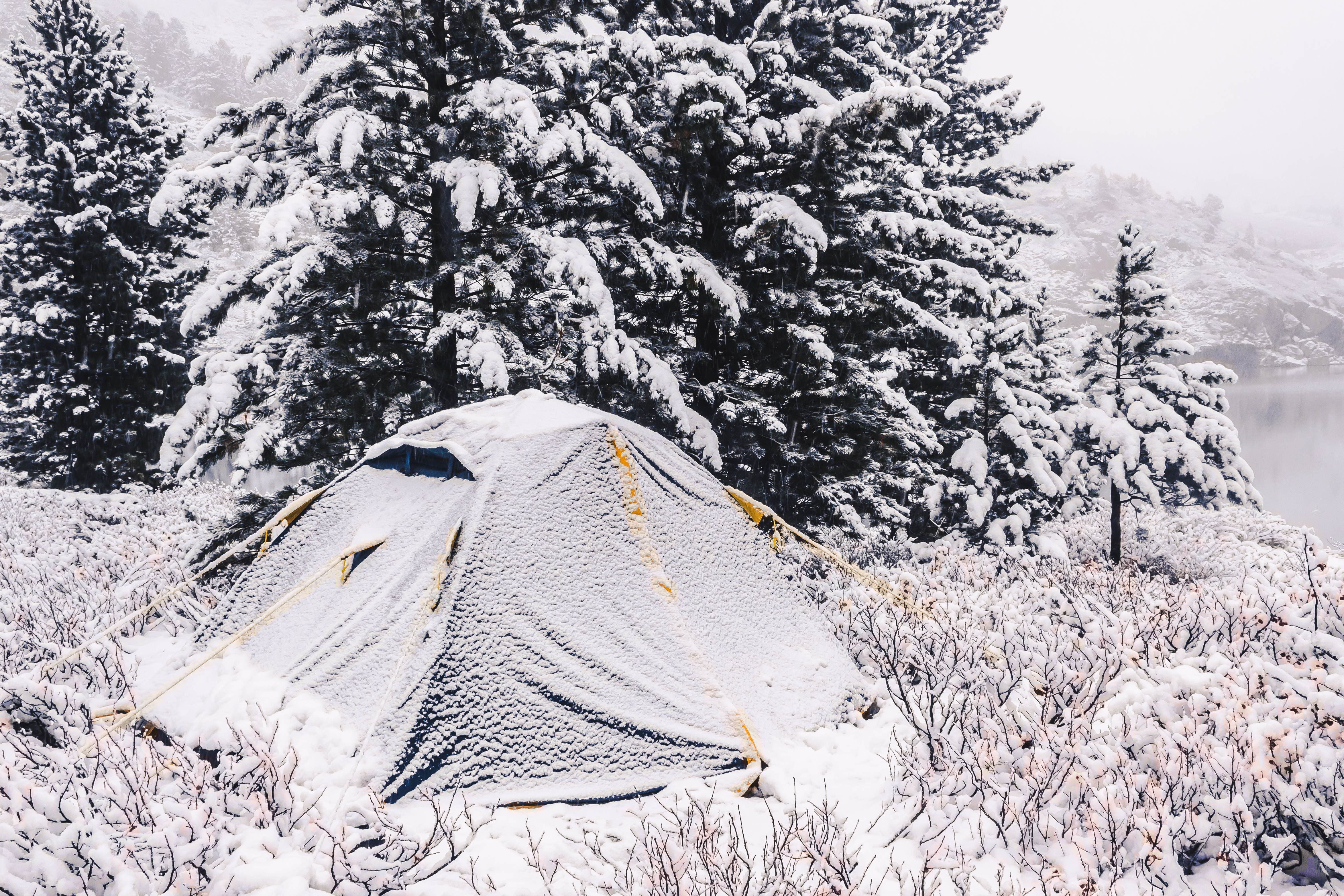
Getty Images, Avdeev_80
Four-season tents come in a variety of shapes and sizes. When you're shopping for one, you'll want to consider:
There's no sense in buying a four-season tent for winter camping if the tent can't actually hold up to winter weather. Its "stormworthiness" should be the first thing you consider when looking to buy a four-season tent.
Of course, not everyone needs the most bombproof winter tent out there. Take a look at what your actual winter camping plans are, and what conditions you're likely to run into. If you're going to be in polar conditions with strong winds and snow, you'll want the most storm-worthy—and therefore heaviest and likely most expensive—tent you can find.
But if you're more interested in camping below the treeline, or only going out when the weather forecast looks decent, you can get away with a lighter, more affordable, and less rugged four-season tent.
Four-season tents are, by nature, not the most packable of outdoor shelters. Because they use thick fabric and the tent poles are often larger than three-season tents, they take up far more room in your backpack.
While I swear by Hillebergs and Mountain Hardwear Trangos, I also generally only use them if I'm pulling a sled. If I'm carrying everything on my back, I'll typically choose a more packable tent, like the Eldorado or Mega Light.
Depending on your mode of transport, you may be willing to take the weight penalty for a heavier tent, or you may want to stick to the more lightweight options.
Floor space in a tent is key for comfort. If you're going to hunker down and wait out a storm in your new four-season tent, you want to ensure you have enough room that you end up sitting, eating, and sleeping on top of your camping partner.
If you're planning on doing some longer expeditions, you may want something roomier to help your sanity during the long tent-bound days. And remember, you'll have more layers and gear while winter camping. These can easily take up half the tent if you let them. Look for tents with inner mesh pockets to help keep things organized.
Vestibules, in my mind, are key to winter camping if you do it a lot. They offer a separate space to stash anything you don't need overnight, instead of bringing all your snowy gear inside the tent where it will inevitably get everything damp. You can also cook in vestibules if they are big enough (though, again, with a flat open to prevent carbon monoxide poisoning). While I'm willing to do without on a shorter trip, a spacious vestibule is a must-have on four-season tents that I'm going to be spending a lot of time in.
As you've no doubt noticed, four-season tents cost a pretty penny. And while it might pain you to cough up what amounts to a mortgage payment on some fabric and poles, when it comes to your survival in the winter wilderness, that tent is your home away from home.
That said, the market for these is relatively small as compared to three-season tents, so once each season's inventory is sold, it's gone until next fall. That means you should plan way ahead to purchase one. Otherwise, you may find yourself shopping for a used tent at the last minute—which, frankly, isn't necessarily a bad thing. All of my four-season tents are used because by the time I realize I need one, they're out of stock. Plus, they're also much cheaper. My favorite used gear site for tent shopping is GearTrade, though I've also had great luck on eBay.
Your Questions, Answered
A four-season tent is specifically designed to withstand winter conditions, while most three-season tents are only designed for spring, summer, and fall. Four-season tents are built with thicker walls and tent poles to provide a sturdy shelter during high snowfall or wind events. They are also designed to better trap body heat within the tent, keeping you warmer in cold temperatures. However, they're often misnamed and really should just be called "winter tents," as these features make them sleep far too hot in warmer temperatures.
In addition, some four-season tents have larger vestibules (or more than one) and two doors, giving you more room to store snowy gear separate from your sleeping area and an alternate escape route if one door gets buried in the snow.
If you're going to be camping in the snow several times a year in the winter, or at high altitudes in the spring or fall, yes, you should invest in a four-season tent.
They're expensive, however, and if yours is just a once-a-year trip or something you're not sure you'll like, you might try renting or borrowing a four-season tent before making the financial commitment.
If you're going out in extreme weather—think heavy snowfall and strong winds in an exposed, treeless environment—stick with the Mountain Hardwear Trango or the Hilleberg Nammatj GT. Both of these tents are designed for bad weather and are the tents that I use most frequently while guiding Denali.
Because four-season tents are designed to keep body heat inside and are generally made of heavier material, they are too hot to use in the summer unless you are in the Arctic—and even then, you won't want to lay down in them during midday. The NEMO Kunai 2 could be used as a summer tent in colder climates, but you'll generally want a second, three-season tent to use during the warmer months.
Who We Are
As a mountaineering and backpacking guide in Alaska, Chelsey Cook has spent countless nights out in some of the worst weather imaginable, from winds gusting to 70 miles per hour to three-day-long blizzards to temperatures dropping to -40. Chelsey knows the necessity of a four-season tent you can trust and the dangers of being caught out in a tent that's not able to stand up to the elements. Luckily, she's done the hard work of testing just about every four-season tent for you, so you can skip straight to her favorites.
Editor's Note: Products featured on Wide Open Spaces are independently selected by our editors. However, when you buy something through our links, we may earn a commission.
READ MORE: Crampons vs. Microspikes: Which Should You Use In Wintry Conditions?
